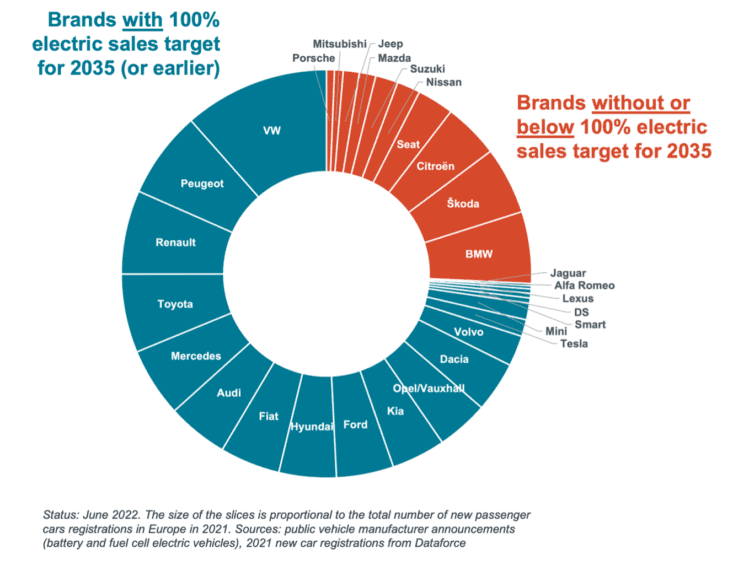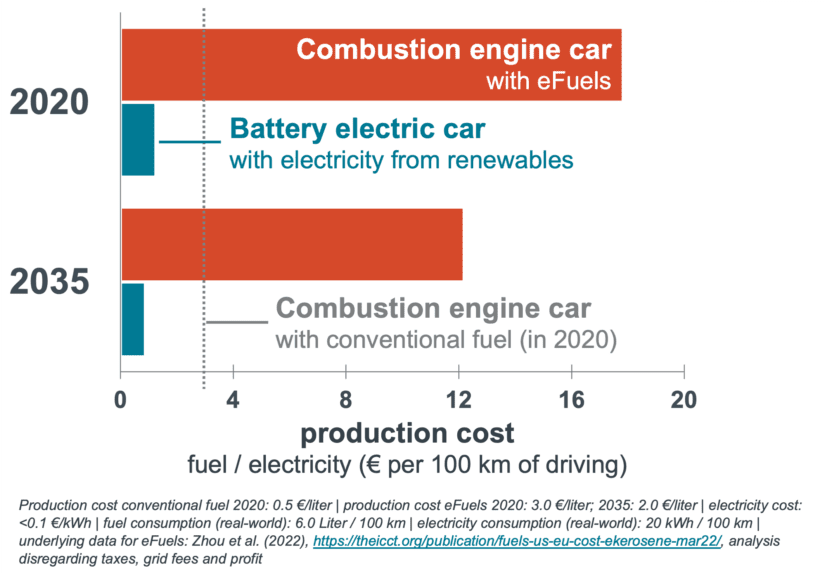Blog
E-fuels: The magic lollipop to keep combustion engines alive (or not)
Late Tuesday night, the Council of the European Union, represented by the Environment Ministers of all EU member states, reached an agreement about its position on the next round of CO2 standards for new cars and vans. The headline announcement is the Council backing the phase-out of new combustion engine vehicles in the EU by 2035. This is a groundbreaking decision that to some observers may seem like a fairy tale. But it is the political spectacle witnessed in the past days that appears like it was from a fairy tale, rather than the diplomatic outcome.
The end of new combustion engine vehicles is a hard economic reality today, even before a binding regulation has been implemented. The market share of battery electric passenger cars in the EU increased from 2% in 2019 to 10% in 2021. Plug-in hybrid cars account for an additional 9%. Three quarters of all manufacturer brands operating in Europe have already, publicly and voluntarily, announced their intention to sell 100% of their new cars as fully electric by 2035 (Figure 1). Adding up all the manufacturer announcements, including half-hearted ones such as BMW’s “more than 50% fully electric by 2035,” the anticipated share of battery and fuel cell electric passenger cars in the EU will be about 55% by 2030 and about 84% by 2035. In other words, the market has already decided on the end of new combustion engine vehicles in Europe, even before the revised regulation is in place.

Figure 1. Vehicle manufacturer brand public announcements regarding electric car sales in Europe by 2035.
Still, clear regulatory road markings are necessary to provide planning certainty for car manufacturers, suppliers, and investors. It would also send a strong signal to the rest of the world: The EU is serious about mitigating climate change and reducing its dependence on fossil fuels, not only agreeing to abstract emissions reduction targets but also implementing concrete regulations that will put us on a pathway towards full decarbonization by mid-century.
While what has been described so far is reality, we now come to the fairy tale part of the story. This tale has its origin in March of this year, when Germany’s Environment Minister Steffi Lemke announced at a Council meeting in Brussels that Germany would support the European Commission proposal for a phase-out of new combustion engines by 2035. Lemke’s statement caused quite a stir because in previous years, Germany typically had pushed back on progressive regulation around vehicle CO2 emissions. Now, it seemed, Germany’s 2021 elected coalition government—made up by the Social Democrats, the Greens, and the Liberals—had switched camps and was going to support pulling the EU towards a quicker decarbonization of the road transport sector. In fairy tale speak, Lemke had taken on the role of the brave princess that would lead her kingdom into a bright new future.
The drama evolved only a few days before yesterday’s Council decision. Figuratively, princess Lemke was already on her shiny horse, riding in the direction of Luxembourg, where the Ministers’ meeting took place. A week before the meeting, Lemke’s antagonist, Christian Lindner, head of the German Liberals, jumped from behind a dark tree and barred Lemke’s way. Because the Liberals are part of the German government coalition, although only making up 11% of all votes, Lindner’s ‘No!’ meant that Lemke could no longer ride to Luxembourg to support the phase-out of combustion engines by 2035. It looked like Germany would have to abstain during the vote which likely would have been viewed as stabbing the European Commission proposal in the back.
What followed in the next days was a diplomatic tightrope walk, a political slugfest between the coalition partners, partially carried out in public. In the end stood a compromise agreement, first within the German government, reached just in time on the day of the Luxembourg Council meeting. And a few hours later also within the Council, that embedded Germany’s proposed language into its minutes. That compromise agreement is all about synthetic fuels (so-called e-fuels) and alternative fuels in general. The Council backs a full phase-out of new combustion engine cars and vans by 2035 but adds the following language:
“Following consultation with stakeholders, the Commission will make a proposal for registering after 2035 vehicles running exclusively on CO2 neutral fuels in conformity with EU law, outside the scope of the fleet standards, and in conformity with the Union’s climate neutrality objective. The Commission should also consider to present a proposal on how other sustainable fuels and technologies can contribute to the decarbonisation of the road transport sector beyond 2035.”
Is this newly introduced language a major loophole that will weaken the 2035 phase-out and keep combustion engines alive for much longer? Probably not. Most likely it is more like the magic lollipop in a fairy tale, a sugary distraction that princess Lemke gracefully handed down from her steed to the illusionary giant Lindner romping around on the ground to keep him calm. Why so?
First, the newly added language is only part of a recital clause, the introductory part of the legal document, not an actual article in the proposed regulation. Second, it is not clear what “outside the scope of the fleet standards” means. Essentially, all new cars and vans are subject to the EU CO2 standards. So, is the language maybe only about a handful of specialty vehicles, such as ambulances or firefighters? And third, how can it be ensured that any vehicle is running exclusively on CO2 neutral fuels? The trick with alternative fuels is that their chemical properties ideally ought to be similar to those of fossil fuels, to allow blending them into the regular fuel available at the pump. In the U.S., regulators are still struggling with credits that were introduced for vehicles running partially on ethanol fuel (so-called flex-fuel vehicles), precisely because it is virtually impossible to track whether drivers have actually fueled up with ethanol or simply with regular gasoline.
Given their inherent inefficiency, the production cost of the amount of e-fuels required for driving a combustion engine car 100 kilometers is nearly ten times the production cost of the amount of renewable electricity for driving a battery-electric car the same distance (Figure 2). And the enormous cost difference is expected to shrink only marginally over time. Moreover, this is only one of the reasons why e-fuels do not provide a viable option for keeping combustion engine vehicles alive for much longer.

Figure 2. Production cost of fuel and electricity associated with driving 100 km in 2020 and 2035.
Really worrisome though would be the situation if the Council position would indeed refer to all “CO2 neutral” fuels, not only e-fuels. There are a number of biofuels that may appear to be CO2 neutral and that can be produced at relatively low cost but, in reality, come with massive negative effects on the climate, such as land use change emissions, and higher food prices. At the Council press conference, the host of the meeting, French minister for the energy transition Agnès Pannier-Runacher, referred to synthetic fuels resulting in “cars that would not emit greenhouse-gas emissions” but it is important that a clear definition is reflected in the final minutes of the Council meeting, limiting the scope of the added recital to e-fuels that meet the requirements in the Renewable Energy Directive.
In any case, yesterday’s Council decision marks only the next step in what constitutes the EU ordinary legislative procedure. Almost one year ago, in July 2021, the European Commission came forward with a regulatory proposal. Earlier this month, the European Parliament backed the Commission proposal and suggested some further strengthening, for example by tightening the cap for the so-called ‘eco-innovations’ from 7 gCO2/km to 2 gCO2/km by 2030 and by ceasing any credits for zero and low emission vehicles already from 2025 instead of 2030 (Table 1). The European Council also backed the Commission proposal, again suggesting a couple modifications, the most notable being the CO2 neutral fuels provisions but also asking for a review of the regulation in 2026 instead of 2028, as the Commission had suggested.
Table 1. Selection of elements of the cars and vans CO2 standards and respective positions of the EU bodies.
| Current regulation | European Commission proposal | European Parliament position | European Council position |
| Cars: -15% CO2 by 2025 -37.5% CO2 by 2030 Vans: |
-15% CO2 by 2025 -55% CO2 by 2030 -100% CO2 by 2035 -15% CO2 by 2025 |
Supportive | Supportive |
| Credits for zero and low emission vehicles: In place | Credits removed from 2030 onwards |
Credits removed from 2025 onwards |
Credits removed from 2030 onwards |
| Eco-innovations: capped at 7 gCO2/km p.a. |
Not addressed | from 2025: 5 gCO2/km from 2027: 4 gCO2/km from 2030: 2 gCO2/km |
Not addressed |
| Electric vehicle efficiency: Not addressed |
Not addressed | By end-2023 method for measuring and comparing, by end-2024 efficiency thresholds | Not addressed |
| Review clause | In 2028 | In 2027 | In 2026 |
What will now follow are the Trialogue discussions between representatives of the European Commission, the European Parliament and the Council of the European Union. Over the next months, these three bodies will work to arrive at a final compromise agreement that will then become EU law. It is always difficult to predict how long this last step in the regulatory process will take. But given how close the current positions lie to each other, it seems realistic that we will see a final decision before the end of the year.
And they lived happily ever after? Well, not so fast. The road towards a full transformation of the European transport sector remains windy and rocky. But the phase out of new combustion engine cars and vans by 2035 at the latest is not a fairy tale anymore, no doubts after yesterday’s landmark decision.
